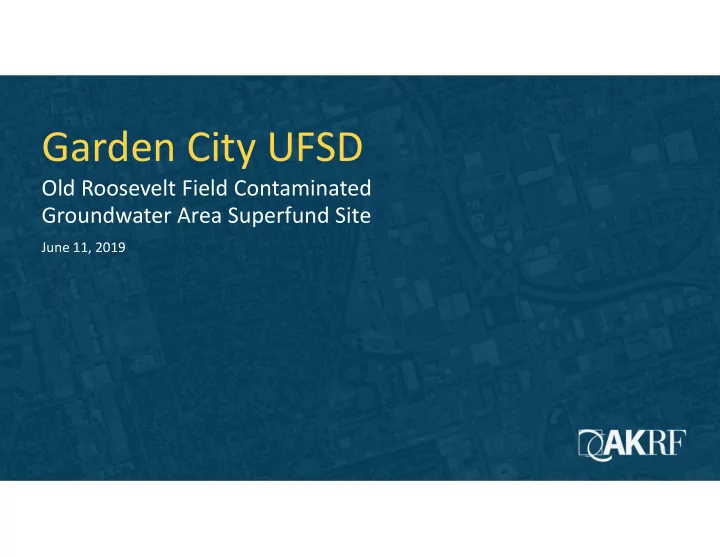

Garden City UFSD Old Roosevelt Field Contaminated Groundwater Area Superfund Site June 11, 2019
About AKRF AKRF is a full-service environmental consulting firm with over 350 employees in 10 offices, including Long Island. • Diverse group of scientists and engineers experienced with EPA Superfund Sites, including groundwater and soil vapor contamination. • On-call consultant to the New York City School Construction Authority for over 10 years dealing extensively with vapor intrusion concerns • Our project team includes Marc Godick, chemical engineer; Adrianna Bosco, environmental engineer; and Stephen Malinowski, environmental scientist/geologist
Background Old Roosevelt Field Contaminated Groundwater Area • Federal “Superfund Site” • Located approximately 1,500 feet north of Locust School • Groundwater beneath the Superfund Site is impacted by chlorinated solvents from historical use as an airfield
Objective In response to a question from a community member, AKRF was • hired by the Garden City UFSD to review available information pertaining to the Old Roosevelt Field Contaminated Groundwater Area Superfund Site and advise the District of potential soil vapor impacts to Locust School
AKRF’s Role Reviewed historical subsurface investigation reports and • remedial plans pertaining to the Superfund Site Evaluated whether Locust School could be affected by vapor • intrusion related to the Superfund Site Prepare a report to the District summarizing our findings •
Groundwater Contamination Plume Locust School
Superfund Site History U.S. Army and U.S. Navy operated the Superfund Site to repair • and refuel military aircraft from 1911 to 1951 Chlorinated solvents were found in public water supply wells in • the 1970/1980s, and the site was subsequently listed on the National Priorities List (NPL) in 2000 Subsurface investigations were conducted under EPA oversight • from 2006-2016 within the Superfund Site and adjacent areas to the south
What are Chlorinated Solvents? Primary Contaminants of Concern include tetrachloroethene • (PCE) and trichloroethene (TCE) Properties of chlorinated solvents: • • Heavier than water, which causes them to sink once in the water table • Contaminated vapors have the potential to enter buildings through cracks and utility lines, causing an exposure concern to occupants
Vapor Intrusion Sources & Pathways
Groundwater Contamination Plume Locust School
Summary of Previous EPA Investigations • Groundwater beneath the Superfund Site contained levels of PCE and TCE above drinking water quality standards • Main route of exposure is through ingestion or direct contact with contaminated groundwater • Soil vapor tested near the source of contamination did not indicate a vapor intrusion concern
Summary of AKRF Findings Groundwater below Locust School is approximately 25 feet below • grade Contamination sinks deeper as it travels south toward Locust School • TCE and PCE groundwater contamination beneath Locust School is • more than 300 feet below grade • An approximate 250 to 275-foot buffer of clean water overlies the TCE and PCE contaminated groundwater, eliminating the vapor intrusion pathway to Locust School
Recommend
More recommend